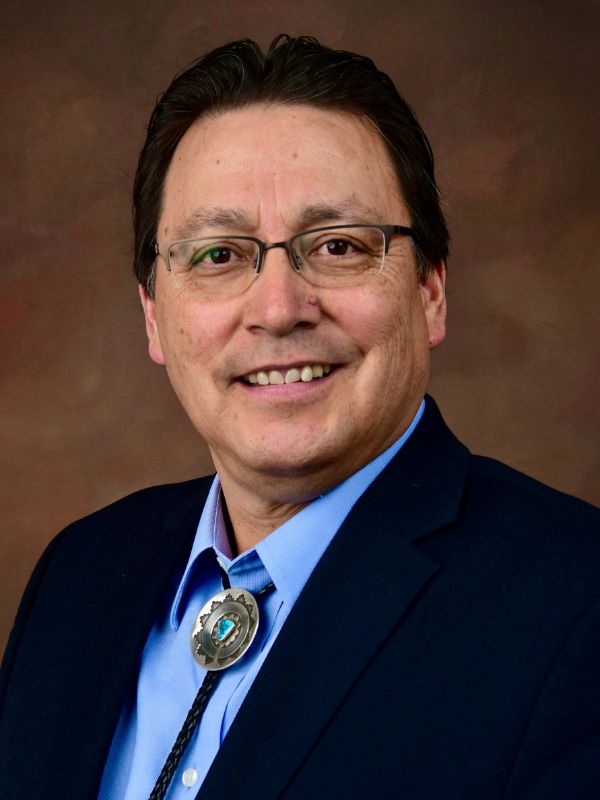
- Details
- By Neely Bardwell
Yesterday, Diné College President Charles “Monty” Roessel walked on in Albuquerque, N.M., surrounded by his family after a long battle with cancer. Roessel was 63.
“It’s with great sadness that I learned this morning of the loss of Diné College President Dr. Charles Roessel,” Navajo Nation President Buu Nygren said in a press release. “Despite his illness, Dr. Roessel continued to valiantly lead Diné College, where he was the beloved president since 2017, and followed in his father's footsteps, Dr. Robert Roessel, the college’s first president from 1968 to 1969.”
Roessel grew up in Round Rock, Arizona, on the Navajo Nation. He graduated from Chinle High School. He then received his bachelor’s degree in photography and industrial arts at the University of Northern Colorado in 1984. He was the first managing editor of the Navajo Times TODAY, where he worked from 1985-1987.
Later, he received a master’s degree in journalism from Prescott College and a doctorate in Educational Administration and Supervision from Arizona State University. In 1990, Roessel became vice president, co-owner and editor of Navajo Nation Today with former Navajo Times TODAY editor and publisher Mark Trahant.
Along with being a journalist, Roessel was a photographer and educator. His work appeared in Time, Newsweek, Arizona Highways and National Geographic. His photography was featured in
the Arizona State Museum exhibition, “Viewpoints: Native Americans and Photography.”
Roessel published his first book in 1995, Songs from the Loom: A Navajo Girl Learns to Weave. It featured his daughter, Jaclyn, who asked her grandmother to teach her how to weave. He published his second book, Kinaaldá: A Navajo Girl Grows Up, in 1993 while he was executive director of the Rough Rock Community School.
2022’s Diné: A History of the Navajos, by Arizona State University Professor Emeritus Peter Iverson, featured Roessel’s photographs.
Rosell worked at Rough Rock Community School from 1998 until 2011, beginning as director of community services and named executive director in 2000 and superintendent in 2007.
He then moved to Diné College, where he led its transition from a two-year to a four-year institution as well as establishing four transdisciplinary schools. These include the School of Diné Studies and Education, the School of Science, Technology, Engineering and Math, the School of Arts, Humanities and English, and the School of Business and Social Science.
Roessel also led the college to begin the Navajo Sovereignty Institute the Navajo Cultural Arts Program, and began the work to create the Navajo Nation’s first law school.
In February 2012, he served as acting director of the U. S. Bureau of Indian Education, the top federal agency dealing with the education of Native children, where he oversaw 66 BIE schools on the Navajo Nation. In December 2013, he was appointed BIE director.
In 2020, Roessel was elected to the distinguished 244-year-old American Academy of Arts and Sciences. He was recognized in the fields of Leadership, Policy and Communications. His class included Indigenous writers, leaders and educators Joy Harjo, Suzan Harjo, Kevin Gover, Greg Sarris, Kay WalkingStick, Edgar Heap of Birds and Aileen Moreton-Robinson.
Roessel is survived by his children Jaclyn, Bryan, Bobbie and Robin, his brothers and sisters Robert, Raymond, Faith and Mary, and many nieces and nephews.
More Stories Like This
Native News Weekly (August 25, 2024): D.C. BriefsUS Presidents in Their Own Words Concerning American Indians
NDAA passes House; Lumbee Fairness Act Advances
NFL, Vikings to Host Native All-American Game, Youth Flag Clinic
Senate Committee on Indian Affairs Passes 12 Bills to Strengthen Tribal Communities
Help us defend tribal sovereignty.
At Native News Online, our mission is rooted in telling the stories that strengthen sovereignty and uplift Indigenous voices — not just at year’s end, but every single day.
Because of your generosity last year, we were able to keep our reporters on the ground in tribal communities, at national gatherings and in the halls of Congress — covering the issues that matter most to Indian Country: sovereignty, culture, education, health and economic opportunity.
That support sustained us through a tough year in 2025. Now, as we look to the year ahead, we need your help right now to ensure warrior journalism remains strong — reporting that defends tribal sovereignty, amplifies Native truth, and holds power accountable.
 The stakes couldn't be higher. Your support keeps Native voices heard, Native stories told and Native sovereignty defended.
The stakes couldn't be higher. Your support keeps Native voices heard, Native stories told and Native sovereignty defended.
Stand with Warrior Journalism today.
Levi Rickert (Potawatomi), Editor & Publisher


